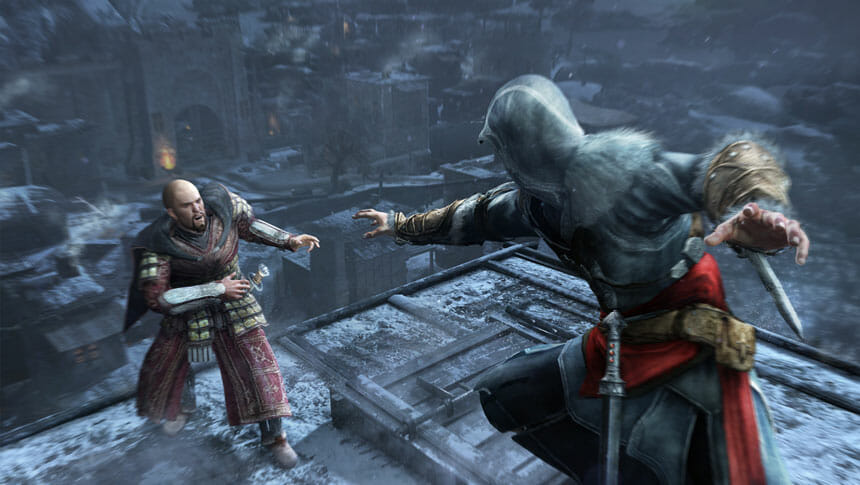Assassin’s Creed: Revelations (Multi-platform)

The third Assassin’s Creed game in three years wraps up Ezio Auditore’s story while introducing tower defense elements.
The Assassin’s Creed series has been somewhat compartmentalized since the first game, its Animus conceit (you’re not directly experienced the historical periods, but rather a reconstruction of them created from the genetic memories of the games’ protagonists’ ancestors) used to explain why everyone speaks English with an accent, rather than their native tongues. The game’s HUD and menus, its limited areas: all because of the simulation.
Revelations is even more compartmentalized than its predecessors. Six Ubisoft studios are named in the opening credits. The game is all over the place, jumping between protagonists and game styles: sometimes you control Ezio during the Renaissance, sometimes you control the first game’s Altair in the 12th century, sometimes you control Desmond in third person in the present day (sometimes in first person). Sometimes you’re commanding a battle on the streets of Constantinople, sometimes you’re moving assassins around the Mediterranean like a Wall Street banker moves around money: just looking at numbers.
Ezio’s still a little clunky to control. Sometimes he’ll jump the wrong way, or attack the wrong target. You do get the hang of the controls, but it’s like it never wants you to get too comfortable with them. Just like the Animus, the controls are always reminding you that you’re playing a game.
Ezio is on unfamiliar ground. One of his blades is destroyed in the opening cutscene, but that’s the only ability he brings over from the previous game that is lost. Constantinople is the West and East, a crossroads of cultures. Assassins are similar, but different. These Arabic assassins’ gear is more technologically advanced than the European Ezio’s: they’ve “borrowed explosives from the Chinese”, as Yusuf Tazim tells Ezio, though they’re now primarily provided by a creepy man who sits in the back of his shop muttering to himself before giving you short missions to train you in using the different bombs. And they’ve got hook blades, an innovation that hasn’t yet made its way to the Roman assassins.
Of course, these technical innovations are meaningless unless they affect gameplay. And they do. Hookblade adds more timing-based controls to the platforming – long jumps, ledge grabs, and climbing leaps all require an additional press of a button. You don’t quite realize how much this affects the movement until you’re forced to do without it in one of Ezio’s flashbacks to Altair’s memories (By this point, Ezio is well aware of the series’s batshit paranoid scifi conspiracy angle, and he plays his role as the middle of a group of assassin nesting dolls well).

Renovating the city returns from Assassin’s Creed: Brotherhood, except in Constantinople the Templars don’t take as kindly to it as they do in Rome. Each upgrade increases “Templar Awareness”. A few times I let it get too high and they attacked one of the dens, leaving me to play that tower defense game to save it. In the previous games what is now the awareness meter measured your character’s “notoriety”. It’s a subtle shift in description that reflects its new effects — as it increases, the guards no longer just notice Ezio. They go after his entire guild in these Den Defense sections.
It makes a lot of sense given Ezio’s progression through his three games: in the first, he is a lone assassin. In the second, he builds up a team that he can call in, as well as the other thieves and soldiers and courtesans that he commands. Now he’s directly commanding troops in battle.
Revelations adds both tower defense and first person segments featuring non-Euclidean doorways. The assassins have always been able to move through space in a way that normal citizens cannot — their rooftop travels a metaphor for their abilities to exist outside of the rules of society (rules more often than not put in place by their Templar enemies). As Desmond reconstructs his memories in the first person Memory segments (unlocked by collecting a certain number of Animus fragments in the Ezio and Altair segments), he gains the ability to create level geometries himself, literally making the space as he needs to in order to move through it. They’re disorienting, and it’s pretty clear why Desmond’s adventures take place in his ancestors’ memories: his are pretty boring.
Almost the entire city is open to you from the start, as are its fast travel tunnels. The game is a little different from other open-world games because it largely doesn’t have to introduce a mission type in the story before it’s open to you in the game. The two exceptions are bomb crafting and Mediterranean Defense.
-

-

-

-

-

-

-

-

-

-

-

-

-

-

-

-

-

-

-

-

-

-

-

-

-

-

-

-

-

-

-

-

-

-

-

-

-

-

-

-










































